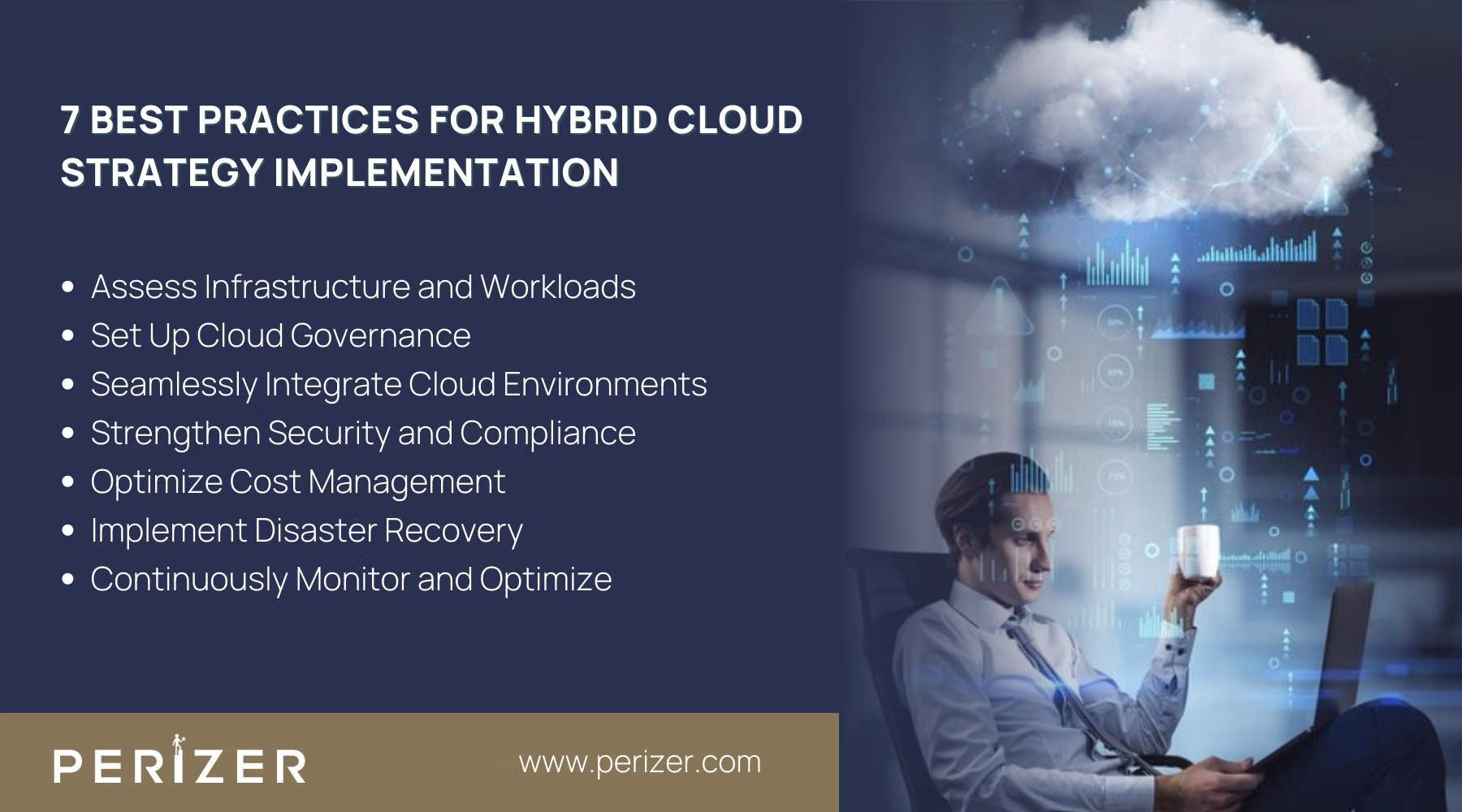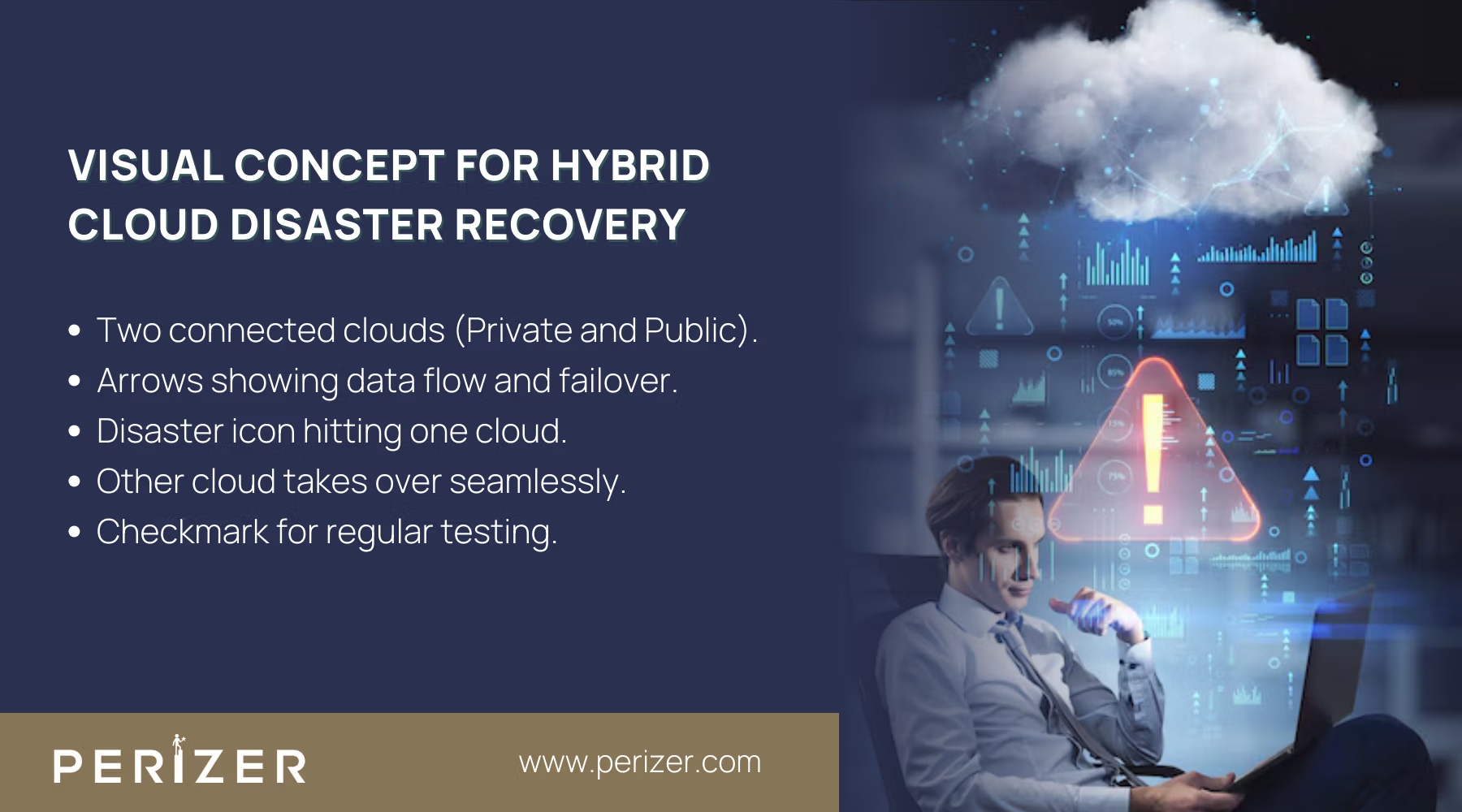7 Best Practices for Hybrid Cloud Strategy Implementation
Discover the essential best practices to optimize your hybrid cloud strategy, ensuring it stays secure, efficient, and ready to scale with your growing business needs

A hybrid cloud strategy combines the best of both public and private cloud environments, allowing businesses to scale resources, manage workloads, and maintain control over sensitive data. It allows you to link your existing systems with cloud services, giving you the advantage of both environments.
But it’s not just about using both together - it’s about building a system that is efficient, secure, and can grow with your business That’s why having a solid plan is so important. Without the right approach, your hybrid cloud can easily become inefficient, open to security risks, and end up costing more than expected.
In this guide, we will explore the seven advanced best practices that will help you fine-tune your hybrid cloud strategy, ensuring it runs smoothly, stays secure, and grows easily with your business.
7 Best Practices for Hybrid Cloud Strategy Implementation

1. Assess Infrastructure and Workloads
To get the most out of your hybrid cloud, it’s important to have a clear understanding of your current setup and how your workloads function. You can’t move forward without knowing where you stand. Many businesses dive into hybrid cloud without fully evaluating their existing systems, which often leads to problems down the road.
Instead, take the time to carefully review your applications, data, and network connections. For example, some legacy systems might not be suited for the public cloud due to compliance or performance issues, while other workloads could benefit from the scalability of the cloud. To make your hybrid cloud as effective as possible, categorize your applications and workloads based on their performance needs, data sensitivity, and compliance requirements.
How to Do It?
You can start by conducting a thorough inventory of your IT assets using network performance monitors and application performance monitoring (APM) tools. These will help you map out your entire infrastructure, showing how applications interact, where data flows, and identifying any bottlenecks. Once you have a clear picture, segment your workloads based on their specific needs.
The workloads that require high scalability, like customer-facing apps, are typically best suited for public clouds, which offer flexibility and cost-effectiveness. On the other hand, workloads dealing with sensitive data or compliance requirements should remain in a private cloud where you have more control over security.
2. Setup Cloud Governance
Strong governance is key to a successful hybrid cloud strategy. With data and apps spread across different environments, the chances of security issues, mistakes, and compliance problems increase. But governance isn’t about making things harder-it’s about setting clear rules to keep your cloud systems safe and well-managed.
The question is: How do you establish governance that is flexible enough to allow innovation but strict enough to protect your business?
How to Set Up Strong Governance?
You can start by organizing your data based on sensitivity and compliance requirements. Sensitive information, such as customer or financial data, should be kept in the private cloud for greater control, while less sensitive data can be stored in the public cloud, where it's easier to scale. Create rules for workload placement. High-performance databases that need quick access should be hosted in the private cloud to reduce latency. Meanwhile, workloads like customer analytics, which don’t need immediate processing, can operate in the public cloud.
To maintain security, use role-based access control (RBAC) to restrict access to sensitive areas, ensuring only authorized users can reach critical systems. Multi-factor authentication (MFA) adds an extra layer of security, ensuring your cloud environment stays secure and efficient.
How It Helps?
Governance ensures your hybrid cloud doesn’t get out of control. It keeps the cloud out of control, ensures compliance with industry regulations, and prevents data from being placed in environments where it doesn’t belong.
3. Seamlessly Integrate Cloud Environments
Integration is the main point of any hybrid cloud strategy. Without seamless integration, you’ll face a destroyed infrastructure where data silos emerge, and application performance suffers. It’s not enough to simply use a public and private cloud you need these environments to communicate effortlessly, enabling workloads and data to move smoothly between them.
How to Integrate Your Clouds Effectively?
To integrate your public and private clouds smoothly, start by using open APIs. These act as connectors, ensuring your applications can communicate across different environments without compatibility issues. This is especially helpful when working with multiple cloud providers.
Development technologies like Docker and Kubernetes also play a key role. They allow you to package your applications so they can run consistently across any cloud platform, making it easier to move workloads without problems. A hybrid cloud management tool is a smart option. It gives you one place to manage both public and private clouds, and with built-in connectors, it makes moving data and applications between them much easier.
4. Strengthen Security and Compliance
Security is important for any cloud strategy, and hybrid clouds bring extra challenges. The more environments you use, the more chances there are for security risks. What works for a public cloud might not be enough for a private cloud, and vice versa. That’s why you need a security plan that covers these differences while keeping everything protected smoothly.
How to Strengthen Security in a Hybrid Cloud?
To improve security in a hybrid cloud, use a zero-trust security model. This means no user or system is trusted automatically, even if they’re inside your network. Every request is verified, reducing the risk of internal threats and helping prevent breaches.
Make sure data is encrypted at all times, whether it's being stored or moving between clouds. Encryption keeps sensitive information safe, especially for organizations handling financial, healthcare, or customer data.
Also, use a cloud security posture management (CSPM) tool to monitor your cloud environments for any security weaknesses. This tool will enforce compliance rules and notify you if any security issues are detected, ensuring your system stays protected.
5. Optimize Cost Management
Managing costs in a hybrid cloud setup can often be a challenge. Without careful planning, it’s easy to overspend on cloud resources. Since hybrid clouds use different environments, each with its own pricing, keeping track of expenses can quickly become tricky. Proper cost management ensures you’re not paying more than you need to.
How to Control Costs Efficiently?
To keep cloud costs in check, start by adjusting your resources to match your needs. Regularly review how much you're using and see if you're overpaying for unused or over-provisioned applications. This way, you only pay for what you need.
Automation can also help. Public clouds offer autoscaling, which automatically increases resources during peak times and scales them down when things are slower. This prevents overspending and keeps your costs under control.
Lastly, use cost-monitoring tools like AWS Cost Explorer or Azure Cost Management. These tools show real-time spending and break down costs by service, helping you quickly find areas to cut back. If you're managing a hybrid cloud, look for tools that give a full view of both public and private cloud costs to stay on top of your spending.
6. Implement Disaster Recovery

Disaster recovery is a must for any business using the cloud. A hybrid cloud setup lets you use the public cloud for easy backups and quick recovery. But it’s not just about saving data-you need a solid plan. Set up automatic systems that take over when things go wrong, so your business keeps running smoothly without interruption.
How to Build a Solid DR Plan?
You can start by backing up your important data in both private and public clouds. This way, if one fails, the other can take over. For example, private cloud backups help you quickly recover sensitive data, while public cloud backups are great for long-term, cost-effective storage.
Set up automatic failover systems so that if your private cloud goes down, the public cloud immediately steps in without any downtime. This ensures your business keeps running smoothly. Finally, regularly test your DR plan. Run a routine to check how well your failover systems and data recovery processes work. These tests should copy real-life situations to help spot and fix any issues, so you're fully ready in case of a disaster.
7. Continuously Monitor and Optimize
The cloud world is always changing, and your strategy should keep up. What works now might not be the best choice next year. That’s why it’s important to keep an eye on your setup and make adjustments along the way. By regularly checking performance, security, and costs, you can make small adjustments that add up to big improvements over time, keeping your hybrid cloud running smoothly and efficiently.
How to Ensure Ongoing Optimization?
Use real-time monitoring tools like Prometheus or Grafana to track resource usage and application performance across your clouds. These dashboards help you spot issues early before they extend.
Be proactive by setting up alerts for sudden spikes or performance drops, so you can fix problems before they cause downtime. Adopt DevOps practices to automate testing and updates through continuous integration (CI) pipelines, ensuring smooth updates across your cloud environments.
How It Helps?
By continuously monitoring, you’re not just keeping your hybrid cloud running - you’re optimizing it. Over time, these small but consistent improvements in performance, security, and cost management will improve the overall efficiency of your operations, ensuring that your cloud infrastructure supports your evolving business needs.
Conclusion
A successful hybrid cloud strategy isn’t just about mixing public and private clouds—it’s about creating a flexible system that supports your business’s growth while staying secure and efficient. By focusing on proven best practices, you can keep your hybrid cloud optimized, cost-effective, and ready to adapt as your needs grow. Continuously fine-tune your approach with regular monitoring, and you’ll build a cloud strategy that grows with your business and keeps you ahead of the curve.
FOCUSED, FAST, GOVERNMENT READY
Stay Tuned With Our Latest Insights

Staff Augmentation
Learn how to select the perfect IT outsourcing partner to promote your team’s capabilities, improve productivity, and drRead more...

Staff Augmentation
Find the perfect staff augmentation partner by aligning your goals, evaluating expertise, managing costs, and ensuring aRead more...

Cyber Security
We focus on understanding the needs, behaviors, and expectations of your users through extensive user research. This infRead more...